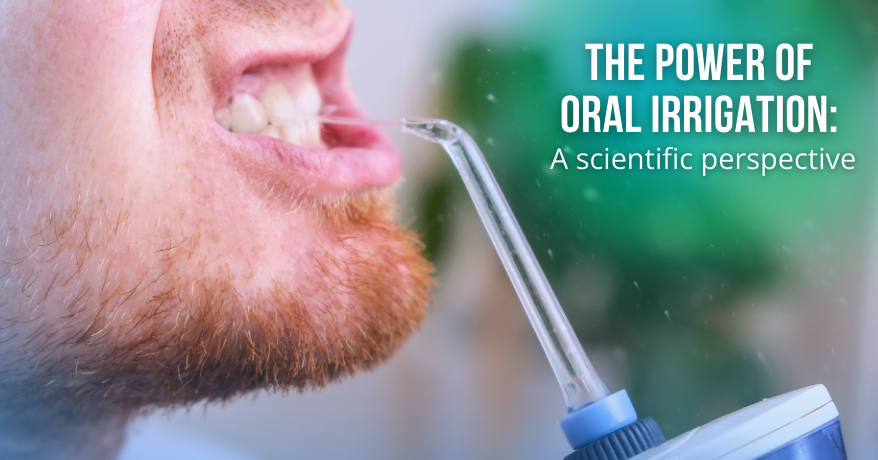Menu

Introduction
As we navigate the intricate landscape of oral health, it becomes abundantly clear that the effectiveness of our oral hygiene routine plays a pivotal role in the maintenance of our teeth and gums. While toothbrushing remains a cornerstone of this regimen, scientific evidence is continually shedding light on the profound benefits of incorporating oral irrigation into our daily practices.
Improving gingival health: A systematic review
In 2008, the International Journal of Dental Hygiene published a systematic review that set the stage for our exploration. This review examined the efficacy of oral irrigation as a supplement to regular toothbrushing. The findings were promising, indicating a positive trend favoring oral irrigation in improving gingival health compared to regular oral hygiene or toothbrushing alone [1].
A global ranking of efficacy: Network meta-analysis
Fast forward to 2018, when the Journal of Periodontology utilized Bayesian Network Meta-Analysis to quantitatively evaluate Interdental Oral Hygiene (IOH) aids. This groundbreaking study provided a global ranking of their efficacy, with interdental brushes and water jets emerging as top contenders for reducing gingival bleeding [2].
The microdroplet device: An alternative to flossing
In the same year, the International Journal of Dental Hygiene explored the acceptance and effectiveness of a high-velocity microdroplet device for interdental cleaning. While dental floss remains the gold standard for narrow interdental spaces, the microdroplet device was well-received and offered an effective alternative for patients who may struggle with traditional flossing routines [3].
Tailored recommendations: Who benefits most?
In 2020, Quintessence emphasized the importance of personalized recommendations, suggesting that oral irrigators can be particularly beneficial for individuals who lack motivation, and manual dexterity, those undergoing orthodontic treatment, and those with specific embrasure types [4].
The impact of oral irrigators in periodontal maintenance
More recently, a 2021 network meta-analysis, featured in Evidence-Based Dentistry, underscored the positive impact of oral irrigators as adjuncts to regular oral hygiene. The data revealed significant improvements in gingival health, bleeding indices, and periodontal pocket depths [5].
Beyond natural teeth: Implants and overdentures
Oral irrigation’s reach extends beyond natural teeth, as demonstrated by a 2021 study published in the Journal of Oral Implantology. This research showcased the effectiveness of oral irrigation in reducing plaque, gingival inflammation, probing depths, and bleeding on probing indices among patients with implants and overdentures [6].
Specialized care for children with visual impairment
A study published in the International Journal of Clinical Pediatric Dentistry in 2022 emphasized the significance of oral irrigators in the specialized care of visually challenged children. The study concluded that oral hygiene maintenance using an oral irrigator, in addition to brushing, was more effective than interdental flossing or brushing alone in this demographic [7].
Orthodontic patients: A unique challenge
For individuals undergoing orthodontic treatment, a 2022 study highlighted the risk of developing unfavorable microbiota. It suggested that the use of an oral irrigator in conjunction with a sonic toothbrush could effectively restore good oral hygiene, reducing the risk of caries and gingivitis [8].
Safety and efficacy: A dual win
Finally, a 2023 study published in the International Journal of Environmental Research and Public Health reaffirmed the safety and efficacy of oral irrigators as
adjuncts to toothbrushing. This research found that oral irrigation significantly improved dental plaque control and reduced gingival inflammation without introducing substantial safety hazards9.
Conclusion
In conclusion, the scientific evidence overwhelmingly supports the inclusion of oral irrigation in our oral hygiene routines. From improvinggingival health to catering to specialized needs, oral irrigators have proven their worth. Whether you’re seeking to enhance your own oral health or exploring options for a loved one, the evidence is clear: oral irrigation is a valuable tool in the quest for optimal oral well-being.
Remember, the pursuit of a radiant smile and healthy gums is not only an aesthetic endeavor but also a fundamental aspect of overall health and well-being. As we continue to unravel the complexities of oral health, embracing evidence-based practices like oral irrigation is a wise and forward-thinking choice.
So, let us all take a step closer to healthier smiles by acknowledging the scientific consensus on the efficacy of oral irrigation. After all, a brighter, healthier future begins with a confident smile.
References:
1. Efficacy of oral irrigation in addition to a toothbrush – Int J Dent Hyg. 2008 Nov ↩ 2. Network meta-analysis of interproximal oral hygiene methods – J of Perio, 2018, May ↩
3. High-velocity microdroplet device for interdental cleaning – Int J Dent Hyg. 2018 May ↩
4. Decision-making for interdental cleaning – Quintessence, 2020 ↩ 5. What is the best mechanical device to clean the teeth in periodontal maintenance patients? – Evid. Based Dent. 2021 Jan ↩
6. Effectiveness of Brushing Associated With Oral Irrigation in Maintenance of Peri Implant Tissues and Overdentures: Clinical Parameters and Patient Satisfaction – J Oral Implantol 2021 Apr ↩
7. Oral Irrigator and Interdental Floss for Plaque Control in Children with Visual Impairment – Int J Clin Pediatr Dent 2022 Jul-Aug ↩
8. Home Oral-Hygiene Protocols during Orthodontic Treatment – Healthcare (Basel) 2022 Nov ↩ 9. Efficacy and Safety of Oral Irrigator on the Control of Dental Plaque and Gingivitis – Int J Environ Res Public Health. 2023 Feb ↩


| PRODUCTS | QTY | PRICE | VALUE in INR |
|---|
| PRODUCTS | QTY | PRICE | VALUE in INR |
|---|